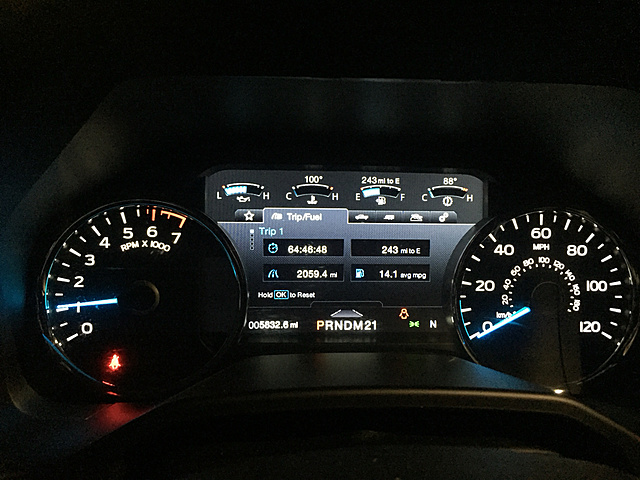Ford F150 Gauges Meaning Explained
In everyday driving most of us only care about how fast we are going, whether or not the engine is overheating and how much fuel we actually have. Years ago these were amongst the few gauges we would see in our Ford F150 but today we have several more.

Some of these newer gauges can be confusing but believe it or not it might be a good thing they are there for you to see. Once you know what they mean they could be the difference between completing your journey or having a breakdown at the side of the road.
In this post we will take a closer look at all the gauges your Ford F150 is likely to show you and what they are actually for.
History of the Ford F150 Gauge Cluster
It was in 1997 that Ford introduced their factory gauge cluster into that year's F150 truck model. As mentioned this original gauge cluster only gave very basic information such as fuel levels, oil pressure, coolant temperature and speed.
This general basic layout stayed the same until 2009 when transmission temperature was added to the cluster. It would become a permanent fixture until in 2015 more gauges were added into the mix.
Why Do We Need Gauges?
As mentioned some of the gauges you will see on the dashboard of your Ford F150 are the standard old school gauges that have been on vehicles almost since the motor car was first invented. These are gauges you will have been taught to take note of during your driving lessons.
You obviously know about the speedometer although from my experience some people must not know how to read it because of how stupidly fast they drive. Another common gauge would be the fuel gauge and of course without this we could easily run the tank dry and end up going nowhere fast.
These important gauges make sense when it comes to relevance but what about the rest, why would they matter? Well the simple answer is that if you have a gauge tracking something it’s generally because exceeding or falling short of certain limits can be damaging to the vehicle.
Therefore the reason gauges are important is that they help us know if there are any problems with our vehicles or if we are driving unsafely.
So What Are the Gauges on a Ford F150 Truck?
The number of gauges found on a Ford F150 truck dashboard can vary depending on the year or model but the main ones of importance are as follows:
- Engine oil pressure gauge
- Engine coolant temperature gauge
- Fuel gauge
- Transmission fluid temperature gauge/ Turbo boost gauge (Only for Ecoboost engines)
- Speedometer
- Information display
- Tachometer
The gauges above are the seven main ones found on newer Ford F150 trucks which we will go into in more detail in the next sections of this article.
Engine Oil Pressure Gauge
Oil pressure is an important factor in maintaining the health of internal combustion engines. This has been the case since the invention of the forced lubrication system by Frederick Lanchester. The oil is picked up by a positive displacement oil pump and forced throughout the engine.
This oil is needed throughout the engine to lubricate moving parts which are essential to the smooth operation of the vehicle. To achieve this the system has to maintain the right level of pressure to ensure the oil reaches all the parts of the engine that it is needed.

This is why the engine oil pressure gauge is so important. It measures the pressure with which the oil is being pushed through the system in units known as PSI. This abbreviation stands for Pounds per Square Inch.
The average engine requires 20 – 50 PSI to effectively transport the oil around the engine allowing all the moving parts to remain lubricated. As we speed up the oil pressure increases in response to an increased need to keep the oil moving around the system.
If the oil pressure is too low then oil may not be getting around the engine and parts may start to grind against each other causing damage. Low oil pressure could indicate an oil leak or a failing oil pump, both situations that need to be fixed as soon as possible.
Engine Coolant Temperature Gauge
The internal combustion engine is essentially run by constant small explosions fueled by gasoline and oxygen. Introducing a spark into a piston ignites this combination which in turn rotates the crankshaft. Engines have multiple pistons all of which play host to these small explosions of which there are many every minute the engine is running.
The reason this is important is because these explosions create heat in the engine which if it was not dealt with could quickly cause serious damage. This is why the engine requires a cooling system through which cooling liquid is passed.
This coolant liquid travels through the engine leaching out the heat before specially calibrated valves open to allow the coolant to enter the radiator. The heat of the coolant is then released in the radiator cooling the liquid back down before it goes back into the engine to start the cycle over again.
The engine coolant temperature gauge then is one that keeps track of how hot the coolant liquid is. If the coolant does not cool down as expected this can be a major problem because if it is already hot it can not help remove the heat from the engine itself.
An overheating engine can be damaged very quickly so if the coolant temperature gauge indicates a high value there may be a big problem. This gauge will make it very clear if this coolant temperature is in the danger zone.
Fuel Gauge
As mentioned the internal combustion engine relies on some form or fuel to create the vehicle's movement. This may be gasoline or diesel fuels which will be stored in what is known as the fuel tank. When we start our Ford F150's engine this fuel is directed to the pistons where it will be mixed with air.
The spark plugs create the third element of the combustion process when it creates a spark to ignite this oxygen and fuel mixture. The force of the explosion pushes the piston which in turn helps rotate the crankshaft. The crankshaft's rotation is transferred to the truck's drive wheels and this is what creates forward momentum.

So essentially the combustion engine requires three elements to make it run fuel, oxygen and a spark. The absence of any one of these will lead to the engine failing to start and or run. If then you run out of fuel your truck will no longer run until you get more.
This is why the fuel gauge is an important part of the gauge cluster as it tracks how much fuel is remaining in the storage tank. It gives you indications of how low it is getting and lets you know when you need to get more fuel.
Generally speaking if you are shown the E icon this indicates that the tank has between 1 – 2 gallons of fuel left and needs to be refilled soon. If you continue to drive one the E icon displays you will likely quickly run out of fuel and doing so can cause damage to your engine.
Transmission Fluid Temperature Gauge
Transmission fluid is used for a number of reasons in the operation of your truck's transmission. This is distinct from engine oil and is specifically colored so as not to be confused with it. Engine oil does not enter the transmission system so lubrication is performed by the transmission fluid instead.
This fluid also helps cool the transmission, transmit energy and protect the seals within the system. It is therefore important that this fluid is kept at a suitable temperature. This is something that is tracked by the transmission fluid temperature gauge.
The ideal temperature range for an engine is between 195 – 215 degrees Fahrenheit. This means if transmission fluid is showing temperatures above this range then there is a problem. Exceeding 260 degrees can cause major engine damage.
Speedometer Gauge
This gauge should not really require much explanation as it is something that the driver very much controls unlike many of the other gauges that have been mentioned. This gauge tracks the speed at which the truck is traveling in miles per hour (mph) or kilometers per hour (kph).
It is important to know how fast we are driving as there are legal limits that need to be adhered to or we can get into trouble with the authorities. There is no way to gauge our speed other than the speedometer. We just do not have that capability.
We therefore must keep track of the speedometer to make sure we are staying within the legal speed limits. An electric sensor measures the speed at which our drive wheels are rotating to determine the speed at which we are traveling.
Tachometer Gauge
The tachometer is actually a very handy little gauge as it tracks the revolutions per minute (RPMs) being made by our engines. This is usually measured in the thousands because while running our engines are rotating very rapidly.
As an indication of the speed our engines rotate we generally see 500 – 800 RPM while we are idling at a stop light. When our RPM rate is low we are using less fuel and when they are higher the fuel consumption increases.
Conclusion
I hope this article has helped you learn more about the gauges you will find on the dash of your Ford F150 truck. They can be very helpful in making sure your truck is running smoothly and that there is no risk of damage to your engine.
If however you receive warnings from your gauges you could be developing a problem that needs to be fixed. It is important then that you familiarize yourself with what the gauges should be reading. This will help you spot potential problems before they get worse.
Link To or Reference This Page
We spend a lot of time collecting, cleaning, merging, and formatting the data that is shown on the site to be as useful to you as possible.
If you found the data or information on this page useful in your research, please use the tool below to properly cite or reference Tow Ratings as the source. We appreciate your support!
-
<a href="http://towratings.net/blog/ford-f150-gauges-meaning-explained/">Ford F150 Gauges Meaning Explained</a>
-
"Ford F150 Gauges Meaning Explained". Tow Ratings. Accessed on April 19, 2024. http://towratings.net/blog/ford-f150-gauges-meaning-explained/.
-
"Ford F150 Gauges Meaning Explained". Tow Ratings, http://towratings.net/blog/ford-f150-gauges-meaning-explained/. Accessed 19 April, 2024
-
Ford F150 Gauges Meaning Explained. Tow Ratings. Retrieved from http://towratings.net/blog/ford-f150-gauges-meaning-explained/.